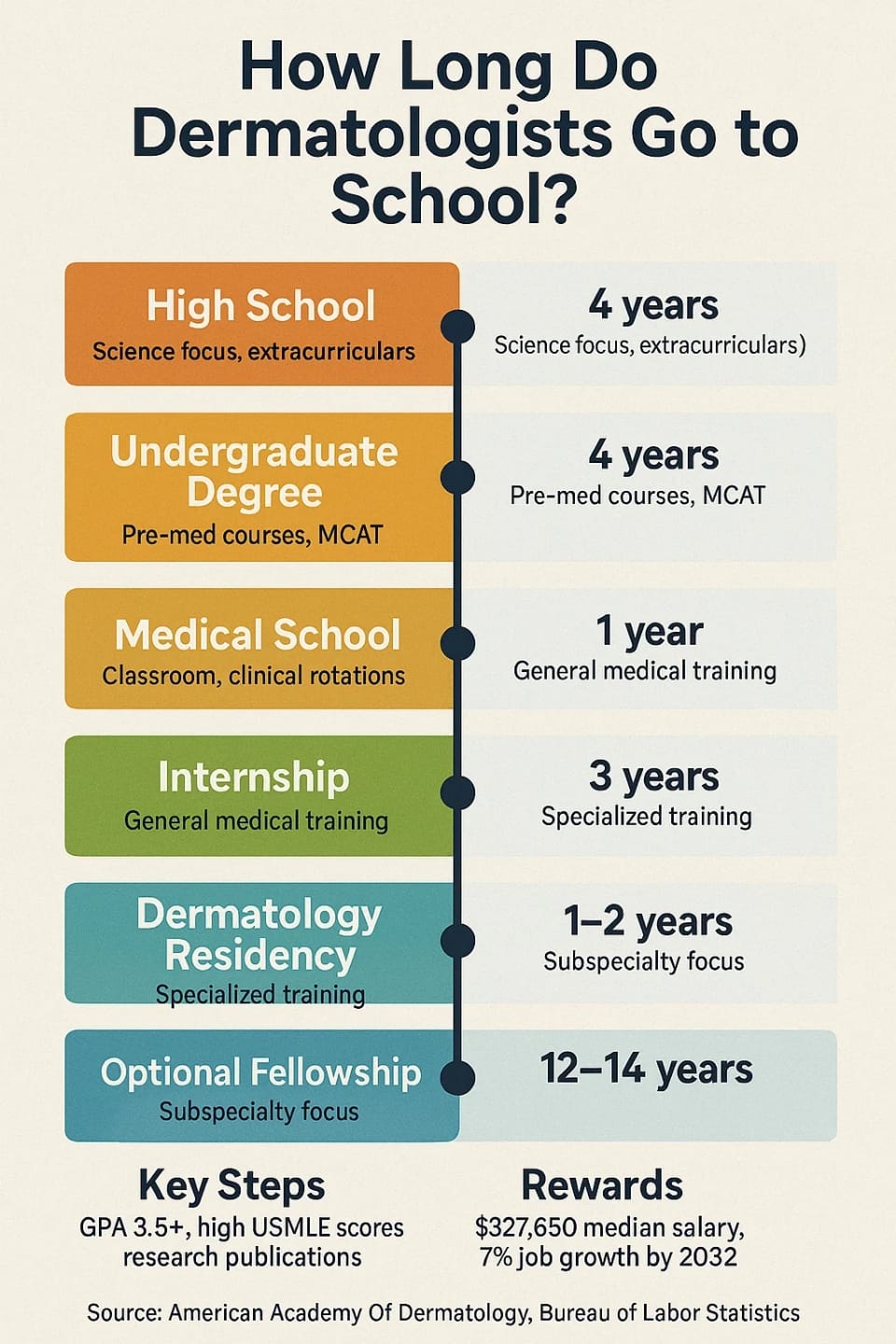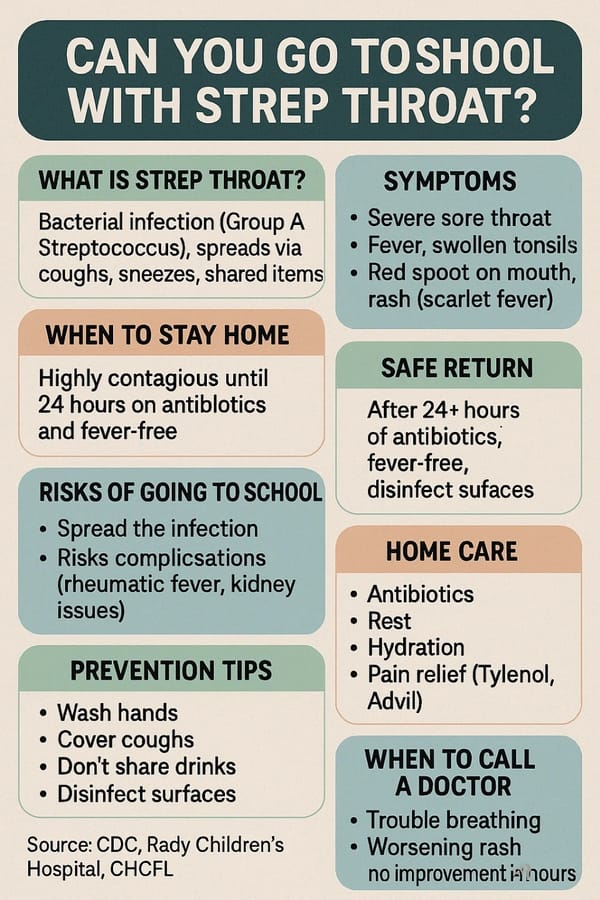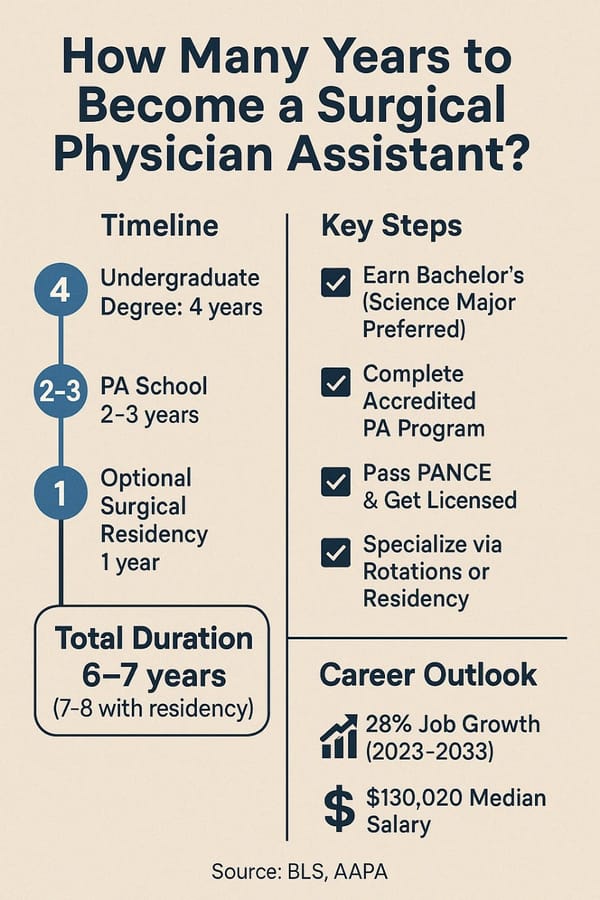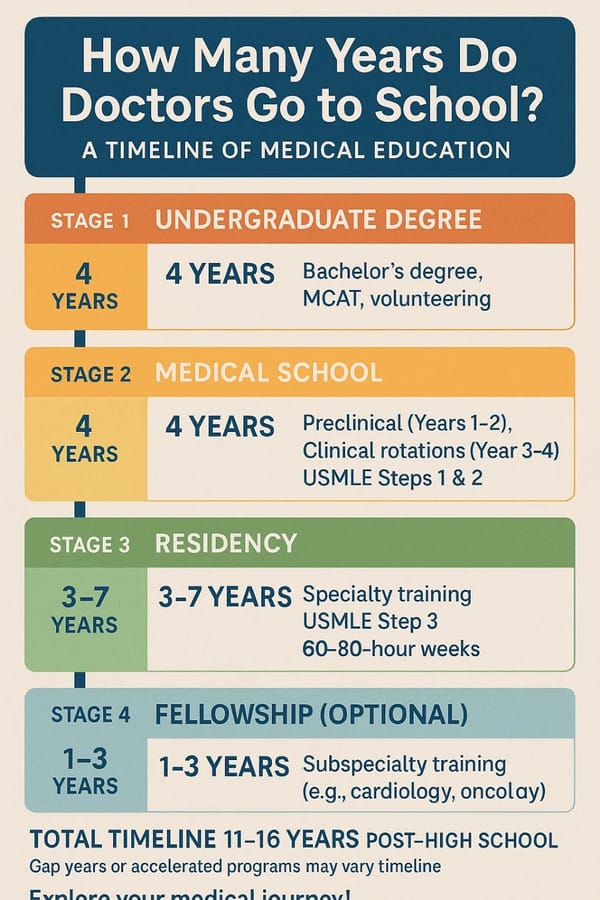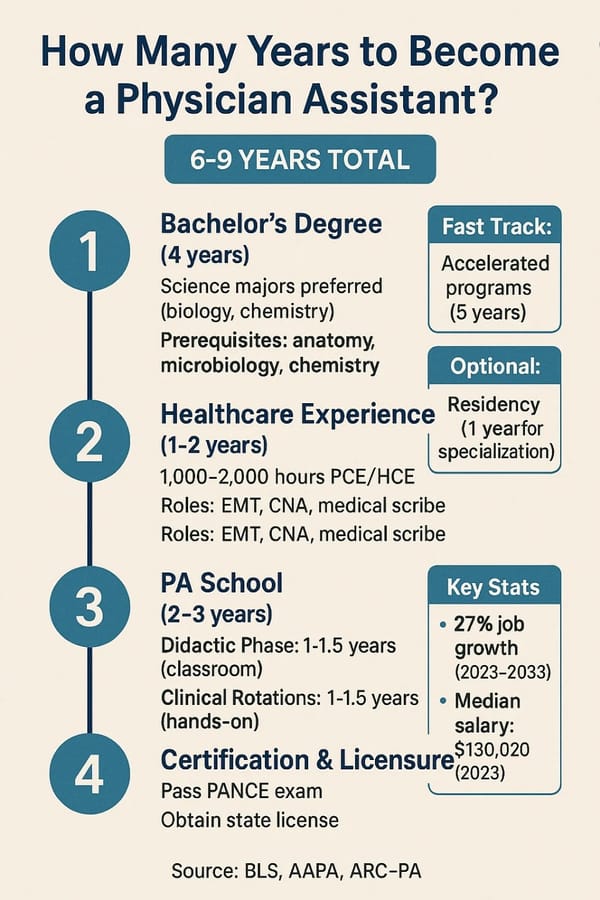How Long Do Dermatologists Go to School? A Comprehensive Guide to Their Educational Journey
The dermatology field stands out as an engaging and fulfilling profession where science meets artistry and patient care to treat conditions ranging from acne to skin cancer. The educational journey of dermatologists raises similar questions for many people who ask “How long do dermatologists go to school?” The journey to become a dermatologist demands long-term commitment and perseverance while nurturing a genuine desire to support patients in maintaining healthy skin. This article presents a comprehensive step-by-step guide from high school through board certification to help aspiring dermatologists and curious patients understand the journey to this dynamic medical specialty.
This guide written from a career advisor’s perspective about medical education serves students who want to pursue dermatology while also helping parents who wish to support their children and professionals considering a new career path. I will share practical tips and relatable anecdotes along this journey to help make this process more achievable and less intimidating. Let’s dive in!
Why Dermatology? Understanding the Appeal
We should explore the reasons behind dermatology's popularity before we examine the timeline. Medical detectives, dermatologists diagnose a wide variety of conditions which affect skin as well as hair, nails and mucous membranes numbering over 3,000. Dermatologists carry out transformative procedures such as cancerous lesion removal alongside cosmetic treatments that build patient confidence. According to the American Academy of Dermatology dermatologists provide essential medical and aesthetic services while building a dynamic and meaningful career.
The field’s competitiveness reflects its appeal. With a median annual salary of around $327,650, as reported by the Bureau of Labor Statistics and a job growth forecast of 7% through 2032, dermatology presents both security and financial benefit. But the journey to get there? It’s no sprint—it’s a marathon. Here’s what it takes.
The Educational Timeline: Step-by-Step Breakdown
After completing high school, the path to becoming a dermatologist requires students to undergo 12 to 14 years of post-secondary education and training. This section will provide a detailed examination of each educational phase from undergraduate studies through optional fellowships including key expectations and strategies for success.
High School: Laying the Foundation (4 Years)
Starting the path to dermatology occurs earlier than many expect. Students should use their high school years to develop a solid academic foundation with a focus on science. Biology, chemistry, physics, and advanced math classes create vital preparation for students who wish to handle pre-med studies. Volunteering at medical facilities and observing dermatologists in their work environment helps ignite student passion while enhancing college applications.
Tip: Work towards achieving excellent grades while beginning your standardized test preparation for exams such as the SAT or ACT. Demonstrating strong academic performance during high school can enable students to gain admission to top-ranked institutions. During my junior year I shadowed a dermatologist which opened my eyes to their patient management and problem-solving skills and strengthened my determination to pursue medicine.
Undergraduate Degree: The Pre-Med Years (4 Years)
Aspiring dermatologists proceed to a four-year bachelor's degree program after graduating from high school. Medical school prerequisites influence most students to choose biology or chemistry majors despite no required field of study. The Association of American Medical Colleges states that these prerequisites often include:
- Biology
- Chemistry (general and organic)
- Physics
- Mathematics
- English
Undergraduates need to study for the Medical College Admission Test (MCAT) after finishing coursework because this test requires 7.5 hours to assess both science knowledge and critical thinking skills. High scores typically above the 90th percentile prove essential for applicants to competitive medical fields like dermatology.
Extracurriculars Are Key: Participate in research projects or volunteer at medical facilities and take charge of pre-med student organizations. These experiences show medical schools you’re committed. A student who I mentored gained valuable resume points by conducting skin cancer research at a local university during the summer which provided her application essay with a strong narrative.
| Course | Credits | Purpose |
|---|---|---|
| Biology | 6-8 | Foundational for medical sciences |
| General Chemistry | 6-8 | Understanding chemical reactions |
| Organic Chemistry | 6-8 | Basis for biochemistry |
| Physics | 6-8 | Principles for medical technology |
| Mathematics | 3-6 | Analytical skills for problem-solving |
| English | 3-6 | Communication skills for patient care |
Medical School: Becoming a Doctor (4 Years)
After medical school acceptance you will begin a four-year course to achieve your Medical Doctor (MD) or Doctor of Osteopathic Medicine (DO) title. The American University of Antigua outlines a typical structure:
- Students will participate in classroom instruction and laboratory exercises covering anatomy, physiology, pharmacology, and pathology during the first two years of medical school. You will develop profound insights into how the human body functions.
- Students complete clinical rotations in internal medicine, surgery, and pediatrics during their third and fourth years. Dermatology rotations provide significant value because they enable students to gain hands-on experience while building relationships with mentors.
Throughout this period students must complete both the United States Medical Licensing Examination (USMLE) Step 1 and Step 2. Excelling in USMLE Step exams is essential for securing a place in a dermatology residency program since dermatology is one of the toughest specialties to enter. According to ProspectiveDoctor dermatology applicants who match typically have an average USMLE Step 2 CK score of approximately 257.
Personal Insight: I guided students through their medical school journey when they felt defeated by its demanding pace. One trick that helped? Create 25-minute study segments followed by brief rest periods. Consistent study habits significantly increase your ability to retain information.
Internship and Residency: Specialized Training (4 Years)
You become a doctor upon graduating from medical school but you still need to complete residency training to become a dermatologist. Following medical school you enter a four-year dermatology residency that starts with a one-year internship period. Here’s how it breaks down:
- The first year of medical training called the Preliminary Year (PGY-1) delivers basic education across internal medicine, surgery, and transitional programs. The internship year provides general clinical training which prepares students before they specialize in dermatology.
- Three-year Dermatology Residency represents the exciting transition to specialized dermatological training. Experienced dermatologists will guide your training as you perfect skin diagnosis and treatment methods. You will learn to conduct biopsies and laser therapies as well as minor surgical procedures. Programs like Yale School of Medicine emphasize hands-on experience, research, and mentorship.
Residents face intense work schedules and elevated performance requirements. Training for the USMLE Step 3 exam will be part of your preparation for obtaining the final medical license. Upon completion you will be equipped to work autonomously or choose to further specialize in dermatology.
Competitive Edge: Dermatology residencies are tough to secure. The National Resident Matching Program indicates successful dermatology residency applicants typically present between 5 and 20 research publications or presentations. Initiate research activities during medical school to differentiate yourself.
Optional Fellowships: Subspecializing (1-2 Years)
Some dermatologists choose to complete fellowships to focus their practice on specialized areas:
- Pediatric Dermatology: Treating children’s skin conditions.
- Dermatopathology: Analyzing skin samples under a microscope.
- Mohs Surgery: Precision surgery for skin cancer.
- Cosmetic Dermatology: Treatments such as Botox injections and laser therapy.
Fellowships generally extend between one to two years and focus on providing advanced training and research opportunities. For example, the UCLA Medical School fellowship offers training in advanced cosmetic dermatology techniques that enhance professional skills and earning abilities.
Is It Worth It?: Fellowships offer valuable skills enhancement and improved marketability yet may not match every individual's career path. While one dermatologist chose to begin a private practice without completing a fellowship, another chose to work in academia after completing dermatopathology training. It depends on your goals.
Licensing and Board Certification: The Final Hurdle
Dermatologists must acquire state medical licenses through passing every USMLE step and fulfilling particular state requirements to practice. Many also seek board certification from the American Board of Dermatology which requires dermatologists to complete a demanding certification process that includes a thorough examination. Although certification is not required by law employers generally seek it to assess professional expertise.
To keep certification active, dermatologists need continuous education while undergoing re-examination every ten years. Medical professionals must continuously update their knowledge to stay current with advancements in dermatological treatments including innovations in laser therapies and psoriasis management.
Total Time: A Quick Summary
Here’s the typical timeline at a glance:
| Stage | Duration | Key Activities |
|---|---|---|
| High School | 4 Years | Science courses, extracurriculars |
| Undergraduate Degree | 4 Years | Pre-med courses, MCAT preparation |
| Medical School | 4 Years | Classroom education, clinical rotations |
| Internship | 1 Year | General medical training |
| Dermatology Residency | 3 Years | Specialized training in dermatology |
| Optional Fellowship | 1-2 Years | Subspecialty training (e.g., Mohs surgery) |
| Total | 12-14 Years |
Challenges and Rewards Along the Way
The road to dermatology isn’t easy. The challenging academic work combined with rising medical school costs and the emotional burden of residency training creates an intense experience for medical students. I’ve seen aspiring dermatologists wrestle with self-doubt, wondering if they’re cut out for such a competitive field. But here’s the truth: if you’re driven by a desire to help patients and learn, you’re already on the right path.
The rewards make every sacrifice worthwhile. Unlike some medical specialties, dermatology offers a balanced lifestyle with more predictable hours and fewer emergencies, as noted by the American Academy of Dermatology. You’ll build meaningful patient relationships, helping them manage chronic conditions like eczema or achieve cosmetic goals that boost their confidence. The field’s mix of diagnostics, surgery, and aesthetics keeps your work engaging and varied.
Real Story: A dermatologist I know shared a defining moment from her residency. Performing her first solo biopsy was nerve-wracking, but detecting an early melanoma saved a patient’s life. “That moment reminded me why I kept going,” she said. These experiences fuel dermatologists through the toughest years.
Tips for Aspiring Dermatologists
Want to stand out on this journey? Here are actionable steps for each stage:
- High School: Enroll in AP science courses and volunteer at clinics. Reach out to dermatologists for shadowing to see the field up close.
- Undergraduate: Maintain a GPA above 3.5, dive into research, and connect with pre-med advisors. Start MCAT prep at least six months early.
- Medical School: Prioritize dermatology rotations, seek mentors, and aim for strong USMLE scores. Publish research to strengthen your residency application.
- Residency: Embrace the workload, ask for feedback, and build a case portfolio. Attend events like American Academy of Dermatology conferences to network.
Common Questions About Dermatology Training
Q: Can I become a dermatologist faster?
A: Some schools, like the Medical University of the Americas, offer accelerated programs, but residency requirements mean 11-12 years minimum.
Q: Is research a must?
A: It’s not required but highly recommended. The Dermatology Interest Group Association notes that publications boost your chances of matching.
Q: What if I don’t match into dermatology?
A: Don’t lose hope. Many reapply after a research year or preliminary residency, as shared by The DO.
Conclusion: Your Path to Dermatology Begins Now
The journey to becoming a dermatologist spans 12 to 14 years of hard work—from high school science classes to residency’s late nights. It’s a path filled with challenges: grueling exams, financial strain, and moments of doubt. But it’s also a journey of growth, discovery, and profound impact. Every step brings you closer to a career where you’ll solve complex cases, transform lives, and blend science with creativity.
Wherever you are—dreaming in high school, grinding through med school, or considering a career shift—take one step today. Research a pre-med program, email a dermatologist, or jot down why this field excites you. Have thoughts or questions? Share them below; I’d love to hear where you’re at! For more guidance, explore the American Academy of Dermatology or connect with mentors who’ve walked this path. Your dermatology future is waiting—start chasing it now!
